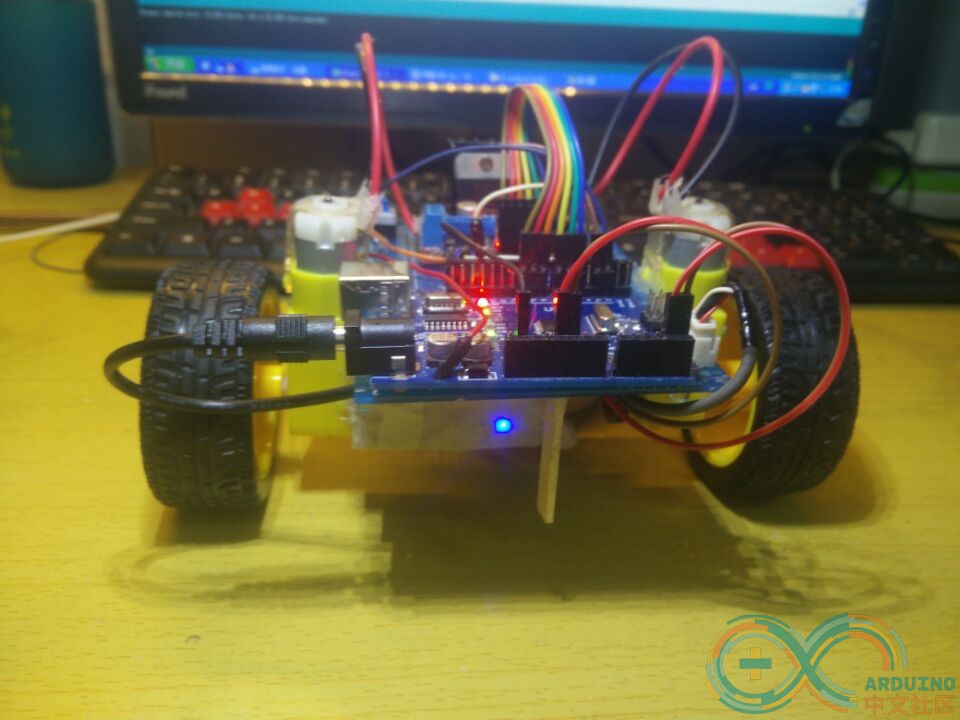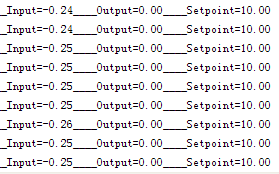
现在小车站立没有问题,但是抖动比较厉害。
程序方面是参考别人的,自己调节了一下参数,但是效果不太理想。
使用的mpu6050,使用的一介互补滤波,得出 角度 angle_x 。
然后通过 if 语句进行判断 if(angle_x>0) 控制L298n
接下来就是把 angle_x 进行PID 控制。 Input = angle_x;
myPID.Compute();
Serial.print(Output=); 通过PID计算得出 Output 疑惑的是 Output竟然是0
![D`Y]%{F@JEA}(0QQBP74{Y6.png D`Y]%{F@JEA}(0QQBP74{Y6.png](data/attachment/forum/201511/24/153248t0ooo2uu01p0yp0u.png)
 Output=0 这是什么原因呢????
Output=0 这是什么原因呢????
然后把Output当做两个车轮的PWM脉冲,
analogWrite(motor1PWMPin, Output);
analogWrite(motor2PWMPin, Output);
Output=0 ,我测量motor1PWMPin motor2PWMPin两个管脚的电压还都是1.75,不管小车角度怎样,电压都不会改变。 ????
设定小车的静态平衡角度为 Setpoint = 10.0;
初始 Input = 0.0;
myPID.SetSampleTime(100); //采样时间
myPID.SetMode(AUTOMATIC);
PID的调节 PID myPID(&Input, &Output, &Setpoint, 1, 0, -10, DIRECT);
调了几天,没什么效果,真是郁闷。。。
又查了一些资料,可能是电机太水,但是也有看到别人用香蕉电机的,效果也还不错。
斗就斗把,后来加了码盘,用了槽型对射管,对两个轮子进行测速,蓝牙控制准备让小车行走,就使用arduino uon 的两个外部中断计脉冲的个数,
标志==40的时候 车轮转动一圈,然后当接收到前进的命令的时候,让两个轮子全部正转2圈,但是经过测试 小车一直在保持平衡,所以没时间正转2圈(这样理解可以吧)。 所以 这个控制程序不会写了。。。请求帮助啊{:soso_e130:}
代码
[mw_shl_code=bash,true]#include<Wire.h>
#include "gyro_accel.h"
#include " ID_v1.h" ID_v1.h"
// Defining constants
#define dt 1 // time difference in milli seconds
#define rad2degree 57.3 // radian to degree conversion
#define Filter_gain 0.95 // e.g. angle = angle_gyro*Filter_gain + angle_accel*(1-Filter_gain)
// Global Variables
unsigned long t = 0; // Time Variables
float angle_x_gyro=0, angle_y_gyro=0, angle_z_gyro=0, angle_x_accel=0, angle_y_accel=0, angle_z_accel=0, angle_x=0, angle_y=0, angle_z=0;
char val ;
int maichong,lefta,leftaa,leftone,righta,rightaa,rightone;
// DC motor driver with L298N
const int motor1PWMPin = 10; // PWM Pin of Motor 1
const int motor1Polarity1 = 9; // Polarity 1 Pin of Motor 1
const int motor1Polarity2 = 8; // Polarity 2 Pin of Motor 1
const int motor2PWMPin = 5; // PWM Pin of Motor 2
const int motor2Polarity1 = 6; // Polarity 1 Pin of Motor 2
const int motor2Polarity2 = 7; // Polarity 2 Pin of Motor 2
const int left=0; //码盘
const int right=1;//码盘
int ValM1 = 255; // Initial Value for PWM Motor 1
int ValM2 = 255; // Initial Value for PWM Motor 2
double Setpoint, Input, Output;
PID myPID(&Input, &Output, &Setpoint, 1, 0, -10, DIRECT);
//PID myPID(&Input, &Output, &Setpoint, 25, 4, -5.5, DIRECT);
void setup()
{
// MPU-6050
Serial.begin(115200);
Wire.begin();
MPU6050_ResetWake();
MPU6050_SetGains(0,1); // Setting the lows scale
MPU6050_SetDLPF(0); // Setting the DLPF to inf Bandwidth for calibration
MPU6050_OffsetCal(); // very important
MPU6050_SetDLPF(6); // Setting the DLPF to lowest Bandwidth
t = millis();
// DC motor
pinMode(motor1PWMPin, OUTPUT);
pinMode(motor1Polarity1, OUTPUT);
pinMode(motor1Polarity2, OUTPUT);
pinMode(motor2PWMPin, OUTPUT);
pinMode(motor2Polarity1, OUTPUT);
pinMode(motor2Polarity2, OUTPUT);
//0 1 zhongduan
attachInterrupt(left, jishu1, CHANGE);
attachInterrupt(right, jishu, CHANGE);
// set enablePin of motor 1 high so that motor 1 can turn on
digitalWrite(motor1PWMPin, HIGH);
digitalWrite(motor1Polarity1, HIGH);
digitalWrite(motor1Polarity2, LOW);
// set enablePin of motor 2 high so that motor 2 can turn on
digitalWrite(motor2PWMPin, HIGH);
digitalWrite(motor2Polarity1, HIGH);
digitalWrite(motor2Polarity2, LOW);
Input = 0.0;
Setpoint = 10.0;
myPID.SetSampleTime(100);
myPID.SetMode(AUTOMATIC);
}
void jishu()
{
lefta++;
if(lefta==45)
{
lefta=0; //mai chong biao zhi qing ling
leftone++;//一圈
}
}
void jishu1()
{
righta++;
if(righta==45)
{
righta=0; //mai chong biao zhi qing ling
rightone++;//一圈
}
}
void rightz()//右轮正转
{
digitalWrite(motor1PWMPin, HIGH);digitalWrite(motor1Polarity1, HIGH);digitalWrite(motor1Polarity2, LOW);
}
void rightf()//右轮反转
{
digitalWrite(motor1PWMPin, HIGH);digitalWrite(motor1Polarity1, LOW);digitalWrite(motor1Polarity2, HIGH);
}
void leftz()
{
digitalWrite(motor2PWMPin, HIGH);digitalWrite(motor2Polarity1, HIGH);digitalWrite(motor2Polarity2, LOW);
}
void leftf()
{
digitalWrite(motor2PWMPin, HIGH);digitalWrite(motor2Polarity1, LOW);digitalWrite(motor2Polarity2, HIGH);
}
void st()//电机停
{
digitalWrite(motor1PWMPin, HIGH);digitalWrite(motor1Polarity1, LOW);digitalWrite(motor1Polarity2, LOW);
digitalWrite(motor2PWMPin, HIGH);digitalWrite(motor2Polarity1, LOW);digitalWrite(motor2Polarity2, LOW);
}
void blue()//蓝牙
{
if (Serial.available() > 0) {
val = Serial.read();
/* if(val == 'A') {
Serial.println(angle_x); //jiaodu
}*/
if(val == 'z') {
rightz();
}
if(val == 'x') {
rightf();
}
if(val == 'c') {
leftz();
}
if(val == 'v') {
leftf();
}
if(val == 'b') {
st();
}
}}
void loop()
{
t = millis();
MPU6050_ReadData();
angle_x_gyro = (gyro_x_scalled*((float)dt/1000)+angle_x);
angle_y_gyro = (gyro_y_scalled*((float)dt/1000)+angle_y);
angle_z_gyro = (gyro_z_scalled*((float)dt/1000)+angle_z);
angle_z_accel = atan(accel_z_scalled/(sqrt(accel_y_scalled*accel_y_scalled+accel_x_scalled*accel_x_scalled)))*(float)rad2degree;
angle_y_accel = -atan(accel_x_scalled/(sqrt(accel_y_scalled*accel_y_scalled+accel_z_scalled*accel_z_scalled)))*(float)rad2degree;
angle_x_accel = atan(accel_y_scalled/(sqrt(accel_x_scalled*accel_x_scalled+accel_z_scalled*accel_z_scalled)))*(float)rad2degree;
angle_x = Filter_gain*angle_x_gyro+(1-Filter_gain)*angle_x_accel;
angle_y = Filter_gain*angle_y_gyro+(1-Filter_gain)*angle_y_accel;
angle_z = Filter_gain*angle_z_gyro+(1-Filter_gain)*angle_z_accel;
digitalWrite(motor1PWMPin, HIGH);
digitalWrite(motor2PWMPin, HIGH);
Serial.print("\n");Serial.print(" ");Serial.print("angle_x="); Serial.print(angle_x);Serial.print(" ");Serial.print("angle_y=");Serial.print(angle_y);Serial.print(" ");Serial.print("angle_z=");Serial.print(angle_z);
Serial.print("____"); //串口输出
// change direction is very important 平衡
if(angle_x>0)
{
myPID.SetControllerDirection(REVERSE);
// set enablePin of motor 1 high so that motor 1 can turn on
digitalWrite(motor1Polarity1, HIGH);
digitalWrite(motor1Polarity2, LOW);
// set enablePin of motor 2 high so that motor 2 can turn on
digitalWrite(motor2Polarity1, HIGH);
digitalWrite(motor2Polarity2, LOW);
}
else
{
myPID.SetControllerDirection(DIRECT);
// set enablePin of motor 1 high so that motor 1 can turn on
digitalWrite(motor1Polarity1, LOW);
digitalWrite(motor1Polarity2, HIGH);
// set enablePin of motor 2 high so that motor 2 can turn on
digitalWrite(motor2Polarity1, LOW);
digitalWrite(motor2Polarity2, HIGH);
}
Input = angle_x;
Serial.print("Input=");Serial.print(Input);Serial.print("____");
myPID.Compute();
Serial.print("Output=");Serial.print(Output);Serial.print("____"); Output 怎么会是0????
analogWrite(motor1PWMPin, Output);
analogWrite(motor2PWMPin, Output);
Serial.print("Setpoint=");Serial.print(Setpoint); Serial.print("\t");
Serial.print("left=");Serial.print(lefta);Serial.print(" ");Serial.print(leftone); Serial.print("\t");
Serial.print("right=");Serial.print(righta);Serial.print(" ");Serial.print(rightone); Serial.print("\t"); //串口输出
blue();//蓝牙
if(rightone==1) //转动1圈标志
{
rightone=0;
st(); // 停止转动
}
while((millis()-t) < dt)
{
// Do nothing
}

|